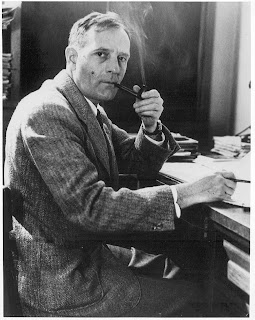In the 1920'ies astronomers learned about stars by looking at the visible light they are emitting. The quality of the observatory was measured by the clarity of night sky without clouds and the amount of distortion caused by the optics used to collect star light. Intensive work was going on in mapping the sky, determining the luminosity of stars, describing their colours and observing their behaviour such as the blinking rhythm of Cepheid stars. Pretty boring job and "computers" where needed to check the photographic plates.
Edwin Hubble was made for the job and would not leave his beloved Hooker. After his 1923 discovery of a Cepheid in the spiral nebula of Andromeda the international community of astronomers had picked up the job and continued hunting for them together with him.
The news that we are citizens of a galaxy called Milky Way and that there are many more out there were slowly reaching the general public. However, space exploration is not a necessity in the same way as medical research to find cure to sickness or meteorology predicting tomorrows weather. People can, and they do, live without knowing much about the huge cosmos and this does not particularly affect their everyday lives. The distances are such that space kind of is a world of its own that only occasionally comes to mind, for example when a bright falling star a meteorite is seen on southern sky. Then we can go on with our business again after having made that wish.
Not so Edwin Hubble. He spent a decade on Mount Wilson examining and taking photos not of distant stars but something much further away - galaxies. He concentrated particularly on the single issue of red shift that Vesto Merlin Slipher had noticed in 1912 using the Clark Refractor in Lowell Observatory.
Systematically and patiently he scanned the skies using spectrography to break the visible light into the colours that together give the galaxy its overall tone.
The dark lines produced by the light emitted by the galaxy is set on the coloured background. On the left side we see the lines from our own star, the sun, and on the right side in comparison to it light from some distant star or galaxy. The arrows show that there is a shift towards red.
So what?
Close your ears, please, I am going to shout now very loud
BIG BANG!!!
The shift in the visible light indicates movement. Red shift is the change in frequency and wavelength of a wave for an observer moving relative to the source of the waves. This is the well known Doppler effect we all know from sounds of passing sirens or trains with the pitch getting higher when it approaches (blue shift of light) or lower when it goes away from us (red shift of light).
Edwin did not just observe that there indeed is red shift indicating that distant galaxies are moving away from us. He did more: using mathematical formulas together with his very accurate observations of the spectrum he established a ratio between the distance of the object measured using Cepheid stars and the amount of red shift seen in the light. Smart guy.
In 1929 he gave, after a decade of careful study, to the world Hubble's Law. It sounds really simple - the galaxies are receding with velocity that is proportional to the distance of the galaxy from us.
But it is not all that easy to conceptualize. Let us assume that we are sitting in the centre of universe. All around us we see galaxies which are trying to get away from us with increasing speed. The further they have reached from us the faster they travel through space. It is as if a huge explosion has blown them into the space.

And God said יהי אור
Modern cosmologists call this huge explosion Big Bang.
In the beginning there was just a dot. Nothing but an insignificant dot. It blew up and voila! particles and atoms and molecules and chemicals and metals and rocks and birds and humans came into being!
Also you and me who wonder was it really just a big bang?
Well
Edwin Hubble
First the guy wins some student boxing fights.
Then he goes and notices that ups! the universe is in reality millions and millions times larger than everybody was assuming and that we are citizens on one galaxy in the midst of billions of others and he also gives a tuning iron to classify these wondrous gardens of stars.
Not satisfied with that he then goes and says that not only the man with the improbable name Vesto Melvin Slipher was right when he noticed red shift in 1912. Those galaxies are speeding away in the space without any fear of a traffic ticket.
No wonder Albert Einstein took the long trip up to Mount Wilson to see the King of the Hill in person.
But especially I like Edwin Hubble for one thing: He said that they should give the Nobel price of physics to Henrietta Swan Leavitt.


No comments:
Post a Comment